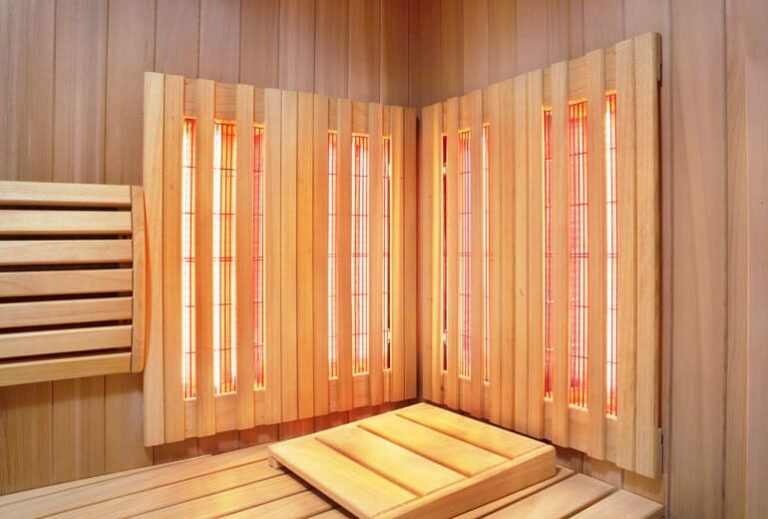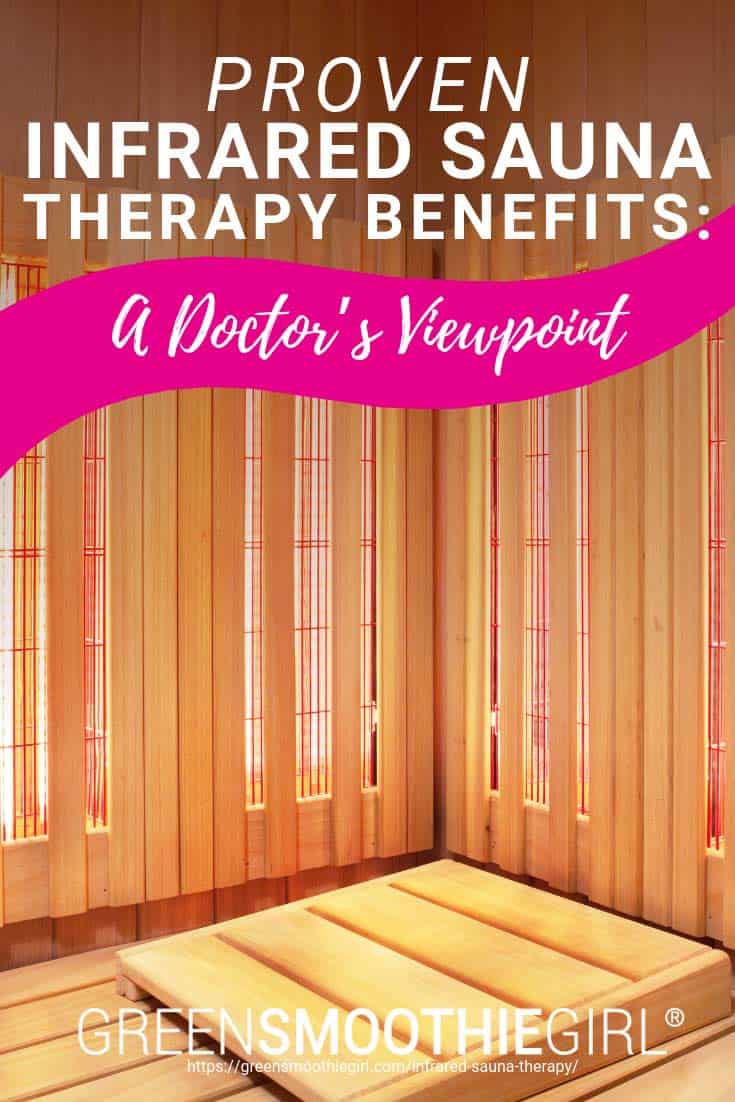Proven Infrared Sauna Therapy Benefits: A Doctor’s Viewpoint

By Dr. Steven Masley, MD, FAHA, FACN, FAAFP, CNS
Note from Robyn: "My dear friend, Dr. Steven Masley, M.D. is one of the most credentialed physicians I know, still vibrant in his late 60’s, a vegan for decades now, a former chef, and a current international sailboat captain as well as practicing heart doctor.
"He’s also a renowned PBS lecturer, bestselling author, and amazing researcher. Recently, he and I did a deep dive into the cardiovascular benefits of using an infrared sauna. I want to share with you what the published research has to say about the use of this powerful tool he and I both have invested in for our homes, to help keep your ticker healthy till you’re 140!
"This article is reprinted with permission from Steven Masley, M.D., and has been edited for clarity."
In this post:
- Sauna Therapy to Burn Calories and Lose Weight
- Sauna Therapy to Detoxify and Remove Harmful Chemicals
- Sauna Therapy for Relaxation
- Sauna Therapy for Cardiovascular Benefits
- Sauna Therapy for Dementia and Memory Loss Reduction
- Who Shouldn’t Use an Infrared Sauna?
- Final Take-Home Message About Sauna Use Benefits
Sauna bathing is a form of whole-body thermotherapy and has been used since ancient times in Roman baths, Aboriginal and Native American sweat lodges, Scandinavian saunas, Turkish baths, Russian banyas, and similarly in Japan with hot water tubs and more recently infrared saunas. These cultures have used whole body thermotherapy to relax, detoxify, and prevent various medical issues for thousands of years. Nowhere is this more popular today than in Finland, where nearly every household has at least one sauna. Recently, a variety of studies, many published in Finland and Japan, have shown the multiple aids of regular sauna use.
The health benefits of regular sauna bathing include:
- Weight loss
- Detoxification (removal of harmful chemicals)
- Relaxation
- Cardiovascular and brain benefits
The mechanism behind how sauna therapy produces these benefits is being actively evaluated. Studies show that it reduces oxidative stress and inflammation pathways, increases nitric oxide (NO, which improves blood vessel function), produces heat shock proteins that impact immune and metabolic function, and enhances insulin sensitivity.
Back in 1981, (when I was already in medical school), the prestigious Journal of the American Medical Association (JAMA) reported that “regular use of a sauna may impart similar stress on the cardiovascular system, and its regular use may be as effective as a means of cardiovascular conditioning and burning calories as regular exercise.”
During the 1980’s, NASA also shared the conclusion that infrared stimulation would help the American astronauts maintain cardiovascular conditioning during long space flights.
Now let’s be clear: this does not mean that taking a sauna can replace the benefits of exercise, but it does mean that regular sauna use complements regular exercise.
So let’s dive into some of these benefits.
Sauna Therapy to Burn Calories and Lose Weight
During a 20-30 minute sauna session, the body core temperature increases by at least one degree (F). To offset this rise in body temperature, the body sweats. During a 20 minute session, the average woman loses 0.5-0.75 pound of body weight in water, while the average man loses 1.0-1.5 pounds. The larger the person is to start, the more fluid they lose.
Fat Loss, Not Water Loss With Sauna Use
I am not counting water loss as body fat loss. The figures on immediate weight loss merely guide users on how much fluid to drink and replace during and after sauna use.
Fat loss occurs because sweating requires the body to burn calories to produce sweat. Studies have estimated that producing one gram of sweat requires 0.5 kcal of energy. The 1980 JAMA article noted above shared that a moderately conditioned adult can sweat up to 500 grams of sweat in a sauna, burning 250-300 calories. And because infrared sauna therapy produces more sweat than traditional hot-air sauna, this makes this newest form of sauna especially useful for weight loss.

30 minutes in a sauna burns the same amount of calories as a 2-mile jog.
On average, a 150 pound person burns about 100 calories for every mile they jog, and in 30 minutes at 5 mph that person could run 2.5 miles. That means a moderate jogging pace over 30 minutes will burn about 250 calories.
Overall, that makes the calorie burn from a 20-30 minute sauna session similar to jogging 2-2.5 miles. My recommendation is that you do some combination of both.
Sauna Therapy to Detoxify and Remove Harmful Chemicals
In a world where chemicals are ubiquitous, even in our food, we need to find better ways to remove chemicals and detoxify. Everyone carries some level of toxic metal load in their bodies.
Chelation Detox
Chelation (a process in which chemicals are used to remove heavy metals and other substances from the body) is one way to remove toxins, but it has real risk when we use chemicals to pull heavy metals and toxins out of body organs and bones and circulate them throughout the body to excrete them. While they are being eliminated through the urine and stool, some are also being redeposited in our brain, kidneys, and liver. Plus, many healthy minerals are removed and lost along with the toxins during chelation.
[Related: How To Safely Detox Your Body]
Sweat Detox
Another way to remove toxins is through sweat. Sweat contains a higher concentration of chemical than blood, then sweating helps pump those heavy metals out of the body. Some of the most worrisome heavy metals in our environment are arsenic, cadmium, lead, and mercury, and all of them are concentrated in body sweat.
- Arsenic concentrations in sweat were 1.5 to 3.0 times greater than are found in blood plasma.
- Cadmium concentrations were four fold higher in sweat than in urine, and 10 fold higher than in blood.
- In people with low lead levels, lead levels in blood and sweat were similar, yet in people with elevated lead levels (workers in a lead battery factory), lead levels in sweat were from 4-10 times greater than the blood.
- Mercury sweat concentrations vary from person to person, but a study showed that the average level in sweat was 0.86 while it was 0.61 in blood and 0.65 in urine, about 30% higher. A small study in mercury exposed workers showed that in people with high mercury blood levels, levels in sweat were at least 10 times higher than in people with normal mercury levels.
Detox From BPA
Another ubiquitous toxin in the environment is Bisphenol A (BPA), which is commonly found in the lining of food containers, especially cans. High levels of BPA increase the risk for diabetes, memory loss, and cancer. In a study performed in Canada, researchers showed that with sweat collected from infrared sauna therapy, BPA concentrations vary from 2 to 20 times higher in sweat than in blood and are typically higher in sweat than urine as well. This makes sweating in a sauna one realistic mechanism to help remove BPA.

Sweating in a sauna is an effective way to remove toxins.
The bottom line from studies is that there is a gradient with higher concentrations of chemical compounds in sweat than are in the blood, and that the skin can excrete more heavy metal and toxins per day in sweat than can be removed during 24 hours of urination. Sweating is clearly a useful way to enhance detoxification.
Liver Detox
However, I must point out that most detoxification is provided by the liver, not through sweating. Eating healthy food (especially foods like onions, garlic, and cruciferous vegetables that help the liver detoxify and remove chemicals) will have a much bigger impact on total detoxification than sweating. Avoiding toxic food is another essential way to reduce total toxic body load.
The bottom line is that sweating is a great way to compliment a detoxification program.
Sauna Therapy for Relaxation
Infrared saunas provide an effective way to increase circulation and muscle relaxation. Athletes have used saunas for centuries to promote healing and recovery after a workout.
A few studies suggest that they may benefit people with depression and anxiety. I suspect but have not seen scientific studies showing that sauna use in the evening improves quality of sleep.
Sauna Therapy for Cardiovascular Benefits
One of the concerns with sauna therapy has been that for people with bad hearts (in particular congestive heart failure), the high heat and dramatic sweating might stress the heart and cause serious adverse events. However, multiple studies in subjects with advanced heart failure have showed that with proper sauna use, sauna therapy resulted in better blood pressure control, reduced cardiomegaly (people with heart failure often have abnormally enlarged hearts, which improved with sauna therapy), and showed improved exercise tolerance, all without any adverse effects being reported.
Sauna Helps Even Heart-Diseased Patients: Studies
Fortunately, it appears that sauna therapy is good for your heart, even if you have heart failure. Of course people with heart disease should first consult their own physician before using sauna therapy as everyone’s situation is unique.
The reason for the improvements in heart function in humans are not totally known, yet from animal studies we know that infrared sauna therapy enhances blood vessel function and increases the production of nitric oxide, improving blood flow and blood pressure control.
There are three recent and important studies out of Finland showing a relationship between frequent sauna use and a reduction in cardiovascular disease and memory loss.
One such study from Finland, published in 2018, showed that regular sauna use is associated with a substantial decrease in stroke risk. They assessed 1,628 men and women age 53-74 and compared frequent sauna use (4-7 times per week) with rare use (once per week or less). After nearly 15 years, and after controlling for other cardiovascular risk factors (smoking, obesity, cholesterol, etc.), those with frequent sauna use showed a 61% decreased risk for a stroke.
[Related: Green Smoothies For High Blood Pressure Control]
Similarly, another 2018 study published from Finland showed that in 2,266 men followed over 26 years, both cardiorespiratory fitness and regular sauna use were associated with a lower rate of total cardiovascular events. Those with frequent sauna use had 40% less cardiovascular events and death than those with rare use. Those with high levels of cardiorespiratory fitness had 50% less events than those with low fitness. And those with high fitness and frequent sauna use had 60% less cardiovascular events than those low fitness and sauna use. This study advocates the benefit and importance of combining a regular exercise program with sauna use.
Sauna Therapy for Dementia and Memory Loss Reduction
Dementia and memory loss benefits are also associated with sauna use. Again in Finland, with 2,300 healthy men, aged 42-60, and followed over 26 years, and after controlling for multiple risk factors (including age, alcohol consumption, body mass index, systolic blood pressure, smoking status, Type 2 diabetes, previous myocardial infarction, resting heart rate and cholesterol levels), increasing sauna use from once per week to 2-3 days per week was associated with a 22% reduction in dementia rate. And compared to sauna use 4-7 days per week showed a 66% reduction.
Do we need further studies to confirm the cardiovascular benefits of sauna use? Absolutely. Further research is warranted, and we should be starting randomized clinical studies in men and women to better understand these benefits. Yet to date, regular sauna use appears safe and very promising!
Who shouldn’t use an infrared sauna?
The following conditions make sauna use contraindicated:
- Pregnancy. Not enough is known to conclude it is safe.
- Children under 12 years of age. Small children may not tolerate high heat or be able to adequately rehydrate.
- Acute injuries. Overuse syndromes likely benefit from sauna therapy, as the increased heat promotes blood circulation and healing. However, with an acute injury, there is often swelling, and heat makes swelling worse, potentially delaying the recovery process.
- Excessive alcohol or recreational drug use. Excess alcohol use promotes dehydration and dizziness, and should not be a part of sauna use.
- Surgical implants. Although metal pins and artificial joints reflect infrared rays and are not heated during infrared sauna use, always consult with your surgeon as to whether sauna use is appropriate with your implants.
- Specific medications. In particular stimulant drugs like ephedrine, or anticoagulants (such as Warfarin and Eliquis), and corticosteroids appear contraindicated with sauna use. If you are taking medications, always check with your medical provider to clarify if sauna use is appropriate for you.
- Silicone implants. This applies to prostheses for the nose and ears, and potentially breast implants. Silicone won’t melt until very high heat, nearly 200 degrees Celsius, however always check with your surgeon or product manufacturer to be certain.
- Uncontrolled and complex medical problems. If you have uncontrolled diabetes, hypertension, or heart disease, or conditions such as cancer or serious auto-immune diseases, always verify with your physician to confirm if sauna therapy is appropriate for you.
Final Take-Home Message About Sauna Use Benefits
There are multiple benefits associated with regular sauna use. Clearly, it helps to burn calories, detoxify and remove chemicals, and can be used for relaxation. It is also associated with lower rates for heart disease, strokes, and memory loss. Most people should consider regular sauna use to enhance their overall health.
Like many good things, sweating in a sauna can be used to excess. Especially if you don’t replace fluid lost and you become dehydrated. If proper steps are not taken, you risk fainting and injury. Appropriate sauna use requires common sense and rehydration to ensure that you benefit.
Steven Masley, MD, FAHA, FACN, FAAFP, CNS

Disclosure: This post may contain affiliate links that help support the GSG mission without costing you extra. I recommend only companies and products that I use myself.

Posted in: Health Concerns, Healthy Weight, Natural Remedies, Tools & Products















